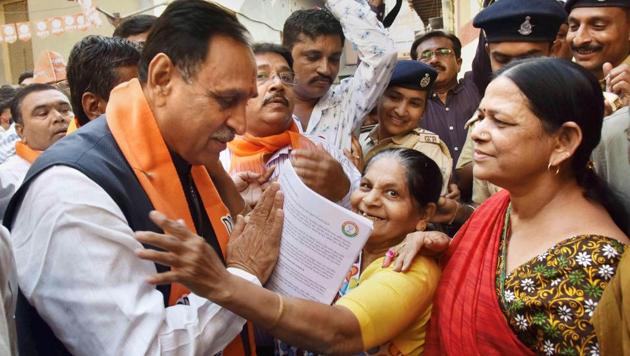Vijay Rupani, an unassuming CM who won millions of hearts for the BJP in Gujarat
Vijay Rupani was sworn in as Gujarat CM for a second time in a row on Tuesday. However, experts see his non-aggressive persona as a shortcoming of the party – which will have to regain lost ground before the 2019 Lok Sabha elections.
Within two months of becoming the Gujarat chief minister in August 2016, Vijay Rupani gave up the traffic privileges due to his convoy in the larger interests of regular commuters.

For Gujarat, which was ruled by Narendra Modi and Anandiben Patel for over a decade, the accessible and low-profile governance of Rupani came as a different yet welcome experience. It was the new chief minister’s self-effacing persona – coupled with a corruption and controversy-free tenure of one-and-a-half years – that made the BJP decide against changing the state leadership before the crucial 2019 Lok Sabha elections.
“I say Rupani is a sarvmitra (friend to all). His friendly approach within the party and outside helped the state gain much-needed stability after Anandiben Patel’s controversial two-year term,” said political analyst Hari Desai.
Though Rupani is close to both BJP president Amit Shah and Prime Minister Narendra Modi, he launched his electoral campaign by seeking the blessings of former chief minister-turned-Modi baiter Keshubhai Patel. It was this ability to connect with everybody that helped the BJP leader become the party’s general secretary and state president before assuming the chief minister’s post.
The BJP’s top leadership positioned him at the helm of Gujarat at a time when the ruling party was caught at the receiving end of social uprisings such as the Patidar quota agitation, the OBC protest against Patidar demands, and the Dalit unrest following the flogging of the four youngsters by self-styled cow vigilantes in Una. The BJP had also lost the state’s countryside in local body polls for the first time in three decades.
Rupani hails from Rajkot, a Jansangh cradle and the main urban pocket of the Saurashtra peninsula. A Jain with RSS roots, he is a vocal proponent of building the Ram Temple at Ayodhya.
The BJP leader became a cabinet minister after winning a by-election from the Rajkot West constituency in 2015. Later, he retained the seat by a margin of over 53,000 votes despite a fierce year-long campaign launched by Indranil Rajyaguru, his Congress opponent and one of the richest candidates in the state. A year on, he had already become the Gujarat chief minister.
If the state was dubbed ‘Vibrant Gujarat’ under Modi and ‘Gatisheel Gujarat’ (progressive Gujarat) under Anandiben Patel, Rupani went with ‘Adikham Gujarat’ (a Gujarat that stands tall). Flagship programmes such as Seva Setu and fairs aimed at providing one-stop solutions to administrative problems faced by the common man were the high point of his government. Even as opponents targeted Rupani on a personal level, he maintained: “I am not here to defeat anyone but to win the hearts of the people.”
But experts view Rupani’s non-aggressive persona as a shortcoming of the party, which will have to regain lost ground before the 2019 Lok Sabha elections. “While his image is free of corruption and controversy, the BJP’s need of the hour is an aggressive leader who can help it recover sufficiently (from the relatively poor showing in the just-concluded assembly polls) before the general elections,” said Desai.
Gujarat, the home state of both Modi and Shah, remains central to the BJP’s narrative for retaining power at the Centre for the second term. After all, it was by showcasing the state’s development model under Modi that the BJP took over the country in 2014.





